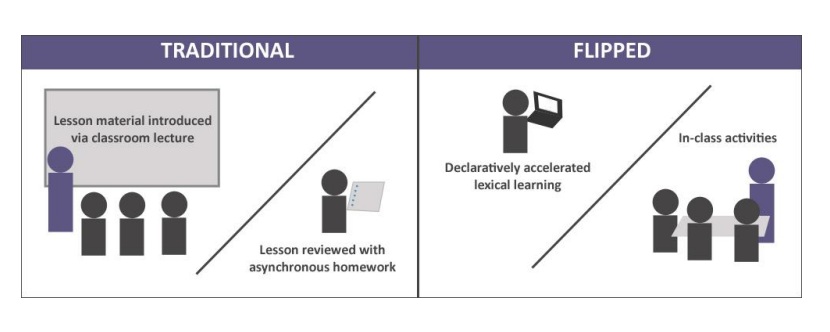Transforming the Economics of Language Learning (Part 3) Posted by Transparent Language on Feb 18, 2015 in Archived Posts
In Part 2 we discussed how technology can transform the economics of language learning, but only if it’s the right technology. Now, let’s look at implementing the right technology in the right way.
You’ve seen those clickbait web ads for “One Silly Trick…” to lose weight, relieve pain or whatever. There’s not usually much value after the click. But for teaching and learning languages, there is a shift in approach—almost simple enough to be a “trick”—that can radically change how quickly and reliably students learn.
We call it DABL, “Declaratively Accelerated Blended Learning.” Obviously we’re not good at catchy names, but if you’re a teacher, you’ve probably come across the term “flipped classroom,” and DABL is something of a flipped language classroom. “Flipped” means doing homework in class and classwork at home.
Unflipped: teacher gives classroom lecture on how to do long division, followed by students doing long division problems at home. Flipped: students watch video on how to do long division at home, and then do problems the next day in class where everyone can see and help each other.
Flipped makes sense because the fixed one-way presentation is absorbed when alone, while the variable anything-can-happen work takes place where others can interact to correct a misunderstanding or celebrate something nicely done.
In language acquisition, the biggest, fixed body of information that needs to be absorbed is lexicon. Thousands of words and phrases need to be mastered to learn another language. If you had the time, you could just notice and absorb words and phrases through immersion, but in professional language programs, that vocabulary and other useful language “chunks” need to be learned deliberately. The alternatives are just too slow and unreliable.
A good teacher might say—and it’s not unreasonable—we’re going to do new things in language together, notice what comes up, and then for homework, you‘ll spend time to master the words and phrases we encounter. That works.
But here’s what works better:
- Someone, perhaps the curriculum designer or the teacher, looks at each lesson in advance and selects the particular words, phrases and language chunks that are the heart of that lesson. What lexical material would best help a student to powerfully engage and excel during the class focused on that language? What vocabulary, phrases, patterns?
- Put those words, phrases and chunks into varied, fast-paced, well-sequenced, computer-delivered activities, and task each student with completing those activities and mastering that lexicon before the class.
- Have that computer (PC, web, mobile or whatever) confirm to the instructor that the work was completed and the material mastered.
- And then… Plan and execute a great class of interesting and compelling task-focused, communicative and peer activities.
- Do the same for each lesson, each class of your course.
Computers are really good at game-like activities that adjust to each student and drive faster mastery. If a student would typically learn 15 vocabulary items in a certain lesson, with DABL he or she can be assigned and successfully master 30. By using that new decontextualized vocabulary in engaging contexts in class the very next day, the learner begins the lifelong process of digesting and adding culturally accurate definition and nuance to those words and phrases. At course end, student lexicons are larger and more robust, and their skills are sharper because they were powerfully armed to excel in each class. Stronger lexicon and stronger skills equals greater proficiency. Greater proficiency in less time—for busy professionals that’s the best trick of all.
See DABL in action in Part 4.

Build vocabulary, practice pronunciation, and more with Transparent Language Online. Available anytime, anywhere, on any device.





Leave a comment: